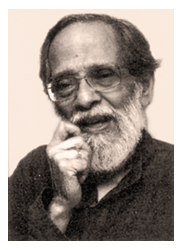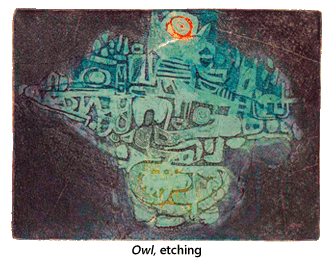- Publisher's Note
- Editorial
- Love of Life (that) Spills Over
- A Continuing Multiplication
- From Painting to Print
- Intimate Involvement
- Portrait of the Artist as an Old Man
- (Hi)Story of the Garhi Printmaking Studios, New Delhi
- Surinder Chadda
- Ramendranath Chakravorty
- Group 8
- Mother and Child: A Screenplay
- Straddling Worlds
- A Brief History of Printmaking at Santiniketan
- Vignettes from History
- Southern Strategies
- The Forgotten Pioneer: Rasiklal Parikh
- Printmaking in the City Of Joy
- Amitabha Banerjee: His Art and Aesthetic Journey
- Local Style and Homogenizing trends: Early Medieval Sculpture in Galaganatha
- English China: Delicate Pallid Beauty
- The Beauty of 'Bilal'
- Photo Essay
- The Way of The Masters: The Great Artists of India 1100 –1900
- Striving Towards Objectivity
- The Art of Sculpting In the Contemporary Times
- An Artistic Framework for an Alternative to Ecology
- Bidriware and Damascene Work in Jagdish and Kamla Mittal Museum of Indian Art
- A Lowdown on the Print Market
- The 'bubble' and the 'wobble'
- What Happened and What's Forthcoming
- Art Bengaluru
- Art Events Kolkata: June – July 2011
- Musings from Chennai
- Mumbai Art Sighting
- Previews
- In the News
- Christie's Jewellery Auction at London, South Kensington
ART news & views
Amitabha Banerjee: His Art and Aesthetic Journey
Volume: 3 Issue No: 19 Month: 8 Year: 2011
Profile
Amitabha Banerjee was born in 1928, in Bengal near Chattagram at an island, Sandwip. He studied at Kargil High School. He was introduced to the Bengal School of Paintings through the 'Prabashi' magazine. Amitabha along with his family settled in Kolkata in the year 1938-39. After graduating from Art School, he secured a job in Kolkata at the U.S.I.S.
He was introduced to the Bengal School of Paintings through the 'Prabashi' magazine. Amitabha along with his family settled in Kolkata in the year 1938-39. After graduating from Art School, he secured a job in Kolkata at the U.S.I.S.
Initially his painting was realistic in nature but later it went through a drastic change and he was intently engrossed in giving new dimension to his art. This was the time when he preferred water colours. Artists Gopal Ghosh and Zainul Abedin influenced him to a great extent with their use of a simple way with warm colours, and life was depicted through this media, especially natural creations and phenomena of the cosmos.
In 1962, Amitabha went for a tour of Europe and America for about six months. Later in Kolkata, in collaboration with the U.S.I.S., he had solo shows at many venues which were highly praised everywhere. Later, he shifted his themes of reality in factual life and started depicting more ornate themes. The bright colours were replaced by dimmer, faded ones. His experiments into different avenues of art, however, continued until the 1970s.
1940s was the time of turmoil in the country. The World War-II, The Quit India Movement of 1942, The Famine of 1943, the Communal riots of 1946 and the Partition leading to the independence of India in 1947 had all left its impression on his paintings. These incidents indeed had stirred the mind of the painter Amitabha but they were not strong enough to imbibe in him the spirit of painting pictures revolving around these incidents.
European Art had its significant influence on Amitabha and had gained his respect and admiration of their creative portrayal.  Cezanne, Matisse, Rembrandt, Van Gogh, Gauguin, Chagall and Picasso's works during the 'Blue period' practically inspired Amitabha, their use of colour, impact of light and shade, unity of form and emotions reflected in the strokes of the paintbrush, enthralled and won over his heart. He was equally fascinated and attracted with the Indian style of painting- the softer colour used, the pace of the picture along with the restrain was something that kept Amitabha forever enticed. He loved the style of the Bengal School though he never used that reflection in his own canvas. He was also influenced by the brilliance of masters like Abanindranath Tagore, Nandalal Bose and Jamini Roy. The characteristic feature of Amitabha Banerjee's paintings, however, was the style that he developed on his own and set a new trend in the contemporary art. In the 1970s, his series of experimental paintings were indicative of the artists uniqueness. His optical vision in reality of the imagery of form is slightly surpassed by an expressionist objectivism. This is further compounded by concealed designs and a lackluster play of light and shade.
Cezanne, Matisse, Rembrandt, Van Gogh, Gauguin, Chagall and Picasso's works during the 'Blue period' practically inspired Amitabha, their use of colour, impact of light and shade, unity of form and emotions reflected in the strokes of the paintbrush, enthralled and won over his heart. He was equally fascinated and attracted with the Indian style of painting- the softer colour used, the pace of the picture along with the restrain was something that kept Amitabha forever enticed. He loved the style of the Bengal School though he never used that reflection in his own canvas. He was also influenced by the brilliance of masters like Abanindranath Tagore, Nandalal Bose and Jamini Roy. The characteristic feature of Amitabha Banerjee's paintings, however, was the style that he developed on his own and set a new trend in the contemporary art. In the 1970s, his series of experimental paintings were indicative of the artists uniqueness. His optical vision in reality of the imagery of form is slightly surpassed by an expressionist objectivism. This is further compounded by concealed designs and a lackluster play of light and shade.
At the beginning of his expressionist phase, Amitabha created a series of paintings on birds. Amitabha's bird series not only carried the significance of the symbols but also expressed the connection of birds to his childhood memories of Sandwip island. These birds allude to the bright and dark faces of society as well as the individuals in his paintings of the 70s and 80s.
Women occupy a major portion of Amitabha's work.  His women are not beautiful in the real sense but are extremely sensuous and attractive. In most of the cases they possess a radiant glow and an exquisite beauty and grace. Indeed, they are very expressive figures.
His women are not beautiful in the real sense but are extremely sensuous and attractive. In most of the cases they possess a radiant glow and an exquisite beauty and grace. Indeed, they are very expressive figures.
Artist Amitabha was an excellent printmaker from the beginning of the 1971. In 1970 US organized an All India Graphic Art Camp, Smithsonian Print making workshop in New Delhi. The famous artist and head of the San Diego University graphic's department Late Paul Lingren was in charge of the camp's lectures and direction. Amongst others present at the camp from West Bengal were Shyamal Dutta Ray, Lalu Prasad Shaw, Suhas Roy and Sanat Kar.
This print making so attracted Amitabha that using this he tried to express all his pent up collected emotions. In the early 1970, when Amitabha was working with the U.S.I.S. in Calcutta, after work he would return home, and would experiment with this form of art until late into the night and that helped him to discover ways and means that were beyond the conventions of the time. In fact, this is how he learned the technique of creating the soft, smooth, velvet-like black colour. He even bought a printing machine and established a self-sufficient Graphics studio at home. For eight years he secretly carried on his experiment on his own.
He would build plates, take printouts but would never show his pictures to anyone. His tireless efforts paid off well. Amitabha, however, was not of the opinion that high quality Graphics Printing is accidental. His popularity spread all over India as one of the pioneers of graphics art. His works were displayed in various exhibitions and he was invited to attend seminars and workshops on art amongst which the West pacific Biennial, in Cuba, Australia, Bangladesh and Europe are worth mentioning. He had attended various workshops on printmaking and painting.
Amitabha Banerjee became the member of the Society of Contemporary Artists in 1971. The Society provided Amitabha with the perfect environment to set up the idea of printmaking. Along with various other forms of art, graphics found its way into Society from its initiation. The graphics studio was set up at the Society's office situated at 157B Lenin Sarani, Kolkata.
the perfect environment to set up the idea of printmaking. Along with various other forms of art, graphics found its way into Society from its initiation. The graphics studio was set up at the Society's office situated at 157B Lenin Sarani, Kolkata.
Amitabha had great practical knowledge in different techniques in printmaking but his favourite was the Intaglio process of printmaking in which he was specially skilled. He has gifted us with many aesthetically rich intaglio along with paintings. His works in water and oil colours and mixed medium works were equally brilliant. Amitabha received many awards for his artistic excellence. A few of them are: Award by Group 8 in New Delhi (1971); for the Best Exhibit in Birla Academy of Art and Culture, Kolkata (1972); as Eminent Artist in the U K (1980); National Award from Lalit Kala Akademi, New Delhi (1980 & 1981); Award for the Best Etching of the Chandigarh Exhibition (1983), the Government of West Bengal (2007) and Rabindra Bharati University (2008) honoured him with a lifetime achievement award.
There is a personal philosophy in the meaning that is expressed from experiences in real life through individual feelings. Often one finds in the portrayal of man, there are flowers, birds, butterflies, blue skies and the like which symbolizes the occurrence of light through the shadows of darkness. The soft, yet beautiful colours like sienna, sepia, purple, amber and Indian red mixes or blends to bring out the unbound passion and emotional romanticism on Amitabha's canvas. He is still constantly engrossed with his tireless strivings for the perfection of his art form, with both determination and whole heartedness.